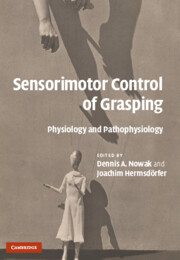Book contents
- Frontmatter
- Contents
- List of contributors
- Preface
- Part I Methodology
- Part II The physiology of grasping
- 10 The study of hand movements during grasping. A historical perspective
- 11 Sensory control of object manipulation
- 12 Predictive mechanisms and object representations used in object manipulation
- 13 The neurohaptic control of the hand
- 14 Points for precision grip
- 15 Two hands in object-oriented action
- 16 Dynamic grasp control during gait
- 17 Development of grasping and object manipulation
- 18 The effects of aging on sensorimotor control of the hand
- Part III The pathophysiology of grasping
- Part IV Therapy of impaired grasping
- Index
- Plate section
- References
15 - Two hands in object-oriented action
Published online by Cambridge University Press: 23 December 2009
- Frontmatter
- Contents
- List of contributors
- Preface
- Part I Methodology
- Part II The physiology of grasping
- 10 The study of hand movements during grasping. A historical perspective
- 11 Sensory control of object manipulation
- 12 Predictive mechanisms and object representations used in object manipulation
- 13 The neurohaptic control of the hand
- 14 Points for precision grip
- 15 Two hands in object-oriented action
- 16 Dynamic grasp control during gait
- 17 Development of grasping and object manipulation
- 18 The effects of aging on sensorimotor control of the hand
- Part III The pathophysiology of grasping
- Part IV Therapy of impaired grasping
- Index
- Plate section
- References
Summary
Summary
This chapter examines object-oriented bimanual coordination and reviews studies which have furthered our understanding of how the central nervous system coordinates the movement of the two hands. Each section deals with different aspects of bimanual coordination and the relevant underpinning neurobiology. First, we describe how bimanual behavior is inherently constrained by the sensorimotor system which preferentially processes and executes symmetrical movements. Second, we discuss how the dynamics of the two hands are integrated to maintain the equilibrium of bimanual performance using anticipatory mechanisms. The third section deals with handedness and how the inherent laterality of our motor system influences bimanual behavior. In the final section, we show how some of the lateral preferences may be over-ridden according to the demands of certain tasks.
Introduction
One hand affords reaching, grasping and manipulation of objects of various shapes and sizes. However, two hands dramatically increase the capacity and range of human dexterity to include larger, heavier objects and to permit greater relative motions of manipulated parts. To achieve coordinated bimanual actions, the kinematics and dynamics of each hand need to be temporally and spatially orchestrated. We consider a number of bimanual manipulative tasks, both in terms of behavioral control issues and also in terms of the underlying neuroanatomy and physiology. A key issue in object manipulation is the use of an appropriate grip force (GF) to maintain stability of the grasped object. Prior to considering bimanual coordination of grasping, we briefly review relevant work on unimanual manipulation of objects.
- Type
- Chapter
- Information
- Sensorimotor Control of GraspingPhysiology and Pathophysiology, pp. 204 - 218Publisher: Cambridge University PressPrint publication year: 2009

